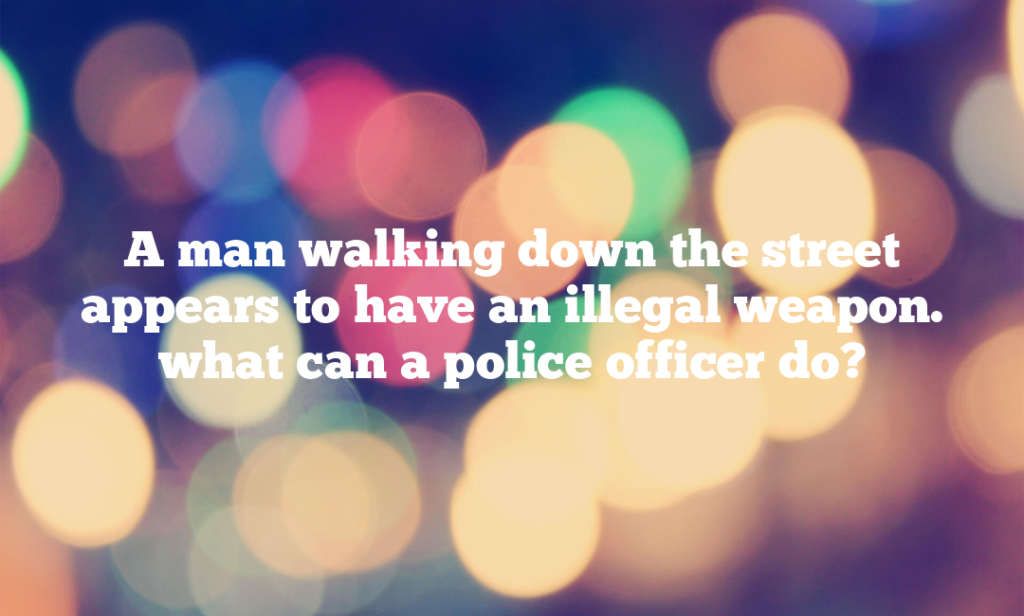A man walking down the street appears to have an illegal weapon. what can a police officer do?
The Crucial Role of Street Patrols in Public Safety
Table of Contents
ToggleStreet patrols by police officers are a fundamental aspect of maintaining public safety. One of the most challenging and sensitive situations they encounter involves dealing with potential illegal weaponry on the streets. This task requires a careful balance between ensuring public safety, respecting individual rights, and protecting the officers themselves.
Understanding the Complexity of Urban Policing
Urban policing involves navigating through a myriad of situations daily. Encounters with individuals who may be carrying illegal weapons are particularly complex due to the potential risk they pose. Officers must be adept at quickly assessing and responding to these situations to prevent harm to themselves, the suspect, and the public.
Legal and Ethical Considerations
Upholding Constitutional Rights
When dealing with suspected illegal weapons, officers must always consider the constitutional rights of individuals. This includes the right to privacy and protection against unreasonable searches and seizures, as well as the right to bear arms.
Navigating Legal Boundaries
Officers are trained to understand and navigate the legal boundaries set by laws and court rulings. This knowledge is crucial in determining when they can legally stop, question, or search an individual based on reasonable suspicion or probable cause.
Approaching Suspected Illegal Weaponry
Initial Assessment and Observation
The first step in dealing with potential illegal weapons involves careful observation and assessment. Officers look for specific behaviors or indicators that might suggest the presence of a weapon, such as visible bulges in clothing or suspicious behavior.
Engaging with Individuals
If an officer deems it necessary to engage with an individual, they are trained to do so in a manner that minimizes risk. This includes using clear, respectful communication and maintaining a safe distance. The initial engagement is crucial in setting the tone for the encounter.
De-escalation Techniques in High-Risk Situations
Importance of De-escalation
De-escalation is a critical skill in high-risk situations. It involves techniques aimed at reducing the tension and potential for conflict. Effective de-escalation can prevent situations from escalating to violence.
Communication as a Tool for De-escalation
Effective communication is a key component of de-escalation. Officers are trained to use a calm, assertive tone and to listen actively. They also use non-verbal communication, such as body language, to convey non-threatening intentions.
The Use of Force: A Careful Consideration
Assessing the Need for Force
The decision to use force is a significant one and is governed by strict protocols. Officers must assess the threat level and consider all alternatives before resorting to force.
Training and Policy on Use of Force
Police departments have specific training and policies regarding the use of force. These policies guide officers on the appropriate level of force to use in various situations, always emphasizing the minimum force necessary to safely resolve an incident.
Post-Encounter Procedures and Accountability
Reporting and Documentation
Following any encounter involving a suspected illegal weapon, officers are required to complete thorough reports. These documents are vital for accountability and oversight and may be used in subsequent legal proceedings.
Review and Analysis
After action reviews and analyses are critical for continuous improvement. These reviews help in understanding what happened, why it happened, and how similar situations can be handled better in the future.
Building and Maintaining Public Trust
Transparency and Community Relations
For law enforcement agencies, maintaining public trust is paramount. This involves being transparent about their practices and actively engaging with the community to build relationships.
Community Involvement and Education
Involving the community through outreach programs and education can enhance understanding and cooperation. It’s important for the public to understand how and why officers respond to potential illegal weaponry as they do.
Conclusion
Navigating public safety when it comes to potential illegal weaponry on the streets is a complex task that requires a well-thought-out approach from law enforcement. This includes legal and ethical adherence, effective communication, de-escalation techniques, judicious use of force, and ongoing community engagement. By focusing on these areas, officers can effectively manage these challenging situations while maintaining public trust and ensuring safety for all.
This article provides an in-depth understanding of the protocols and strategies police officers use when confronting potential illegal weaponry on the streets. It emphasizes the importance of legal and ethical considerations, communication, and community trust in effectively handling these high-stakes situations.




